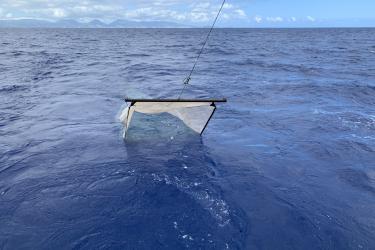After the success story of “Motherload” last year, NOAA Fisheries’ Marine Turtle Biology and Assessment Program was determined to yet again find fertile (or “gravid”) female turtles. They wanted to track their migration from the main Hawaiian Islands to see where they would go to lay their eggs.
On March 12th, 2020, a team of four scientists set out to find a female in the early stages of egg development. Armed with a new field-portable and novel technology ultrasound probe, they were in search of large adult females to scan for ovarian follicles filled with yolk. The volunteers of Mālama na Honu and educators of Laniakea Beach on the North Shore of Oʻahu, told the scientists about a female turtle that had been coming out of the water regularly with behavioral signs of preparing herself for the long journey to her nesting grounds.
When the team of scientists arrived on the North Shore, the turtle was already there. The scientists briefed the interested public on the science project and on how the ultrasound procedure would progress, and set a perimeter to provide space for the scientists to work.
The team captured the turtle, Punahele (“favorite” in Hawaiian), by placing a wooden box around her. The box was designed to prevent her from moving around too much. A wet towel was placed over her head and eyes to keep her calm. They took measurements and biological samples for growth studies, genetic relatedness, and hormone analysis.
A Brief History of Punahele
Punahele was first tagged on May 19, 2010 while resting on the shore (“basking”) on Laniakea Beach. One of the most accepted theories as to why turtles crawl out of the water to bask, other than to lay their eggs, is to thermoregulate. Turtles are cold blooded and use the heat of the sun and sand to warm up after being in the cooler Hawaiian waters. Hawaiʻi is one of three places in the world where green sea turtles crawl ashore to bask. (The other two are Australia and the Galapagos Islands, Ecuador.) This provides researchers with the special opportunity to interact with the turtles because they are more accessible on land than they are in water.
It is also easier to examine the health status and body condition of turtles when they are out of the water, and check for any injuries or entanglements in marine debris. Interestingly, Punahele provides a good example of this. In 2015, five years after she was initially tagged, Punahele was observed with a fishing hook embedded in her left shoulder. A year later, volunteers of Mālama na Honu found her with a derelict fishing line wrapped around her neck and front flippers, which could have strangled her or amputated one or both of her flippers. On both occasions, the hook and lines were safely removed with the help of volunteers and our turtle program’s stranding response team.
In 2015, researchers took the first measurements of Punahele. She came in at nearly 34 inches long (85.9 cm) from the front to the back of her carapace (shell) and nearly 36 inches long (91 cm) when measured front-to-back over the hump of her carapace. That’s about the size of a large truck tire, and is considered adult-sized.
During our team's latest encounter with her in March 2020, the same measurements indicated she had not grown over the past 5 years. The measurements also suggested that she has been sexually mature for many years and that this is not her first nesting season.
Ultrasonography of a Turtle
During a human female’s pregnancy, medical technicians conduct many ultrasounds to determine the sex of the child, growth rates, and anomalies. We can also perform ultrasounds on turtles!
To make it easier, you have to place a turtle on it’s back to access a “pocket” of softer skin closer to the gonads—the “groin” region of the turtle. Because turtles have hard shells, it is impossible to conduct an ultrasound without gaining access to this pocket. It is a short and quick procedure where we place the probe and ultrasound gel (a conductive medium that creates a connection between the probe and the turtle’s skin) between the plastron (underside of the shell) and hind flippers.
On their first try, the team could clearly see developing ovarian follicles filled with yolk on the screen. Jackpot! To confirm what they saw, the scientists scanned her other “pocket" and found developing follicles there, as well.
Cheers erupted from the crowd after the scientists and volunteers relayed the news.
Satellite Tags
In order to track the migration of Punahele to her nesting beach, a satellite tag was applied. The tag, about the size of an adult human's closed fist, was attached with two-component epoxy and an extra layer of epoxy putty around it to make it more hydrodynamic. It also makes it more resistant to males knocking it off during mating, and it allows us to apply antifouling paint to prevent the build up of algae growth, which inhibits satellite transmissions.
Read more about how satellite tags work
Where Will Punahele Go?
During the time that the epoxy was curing, many curious spectators got a close look at Punahele and asked questions about turtles, turtle science, and where the soon-to-be-mama might go. Almost all of the questions were answered except for one: Where will Punahele lay her eggs this season?
Prior to her departure, Punahele spent a month relaxing intermittently on Laniakea Beach—we know this from volunteer observations. She was also seen mating with an unidentified male; he is not known to bask at Laniakea Beach.
On April 13th, Punahele departed from the North Shore. Destination … (so far) … unknown. Watch this space for the continuation of her journey.















